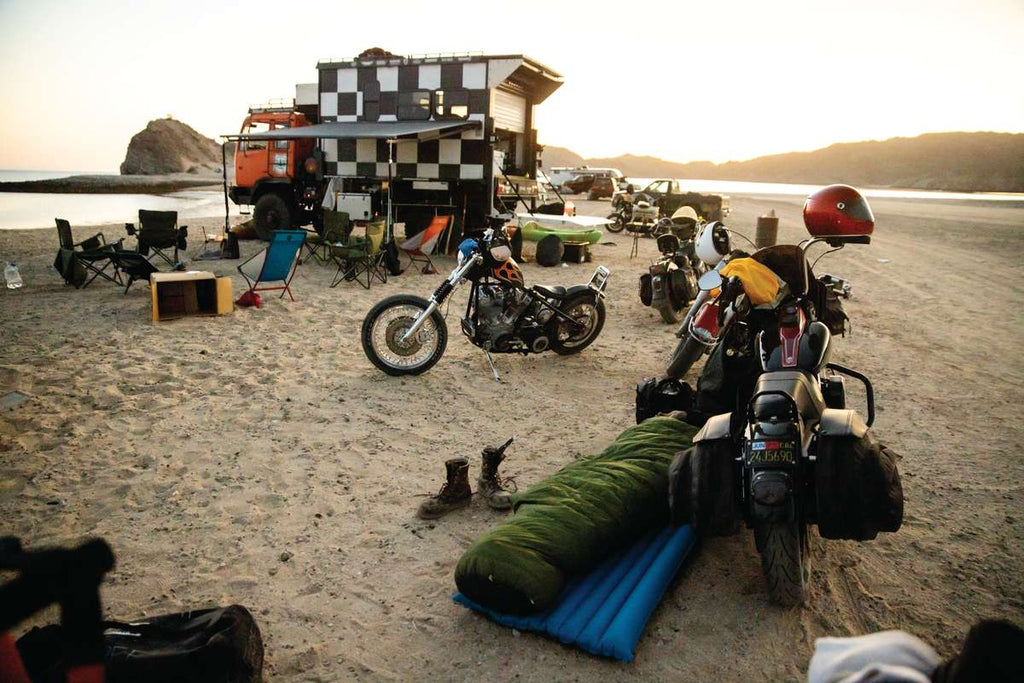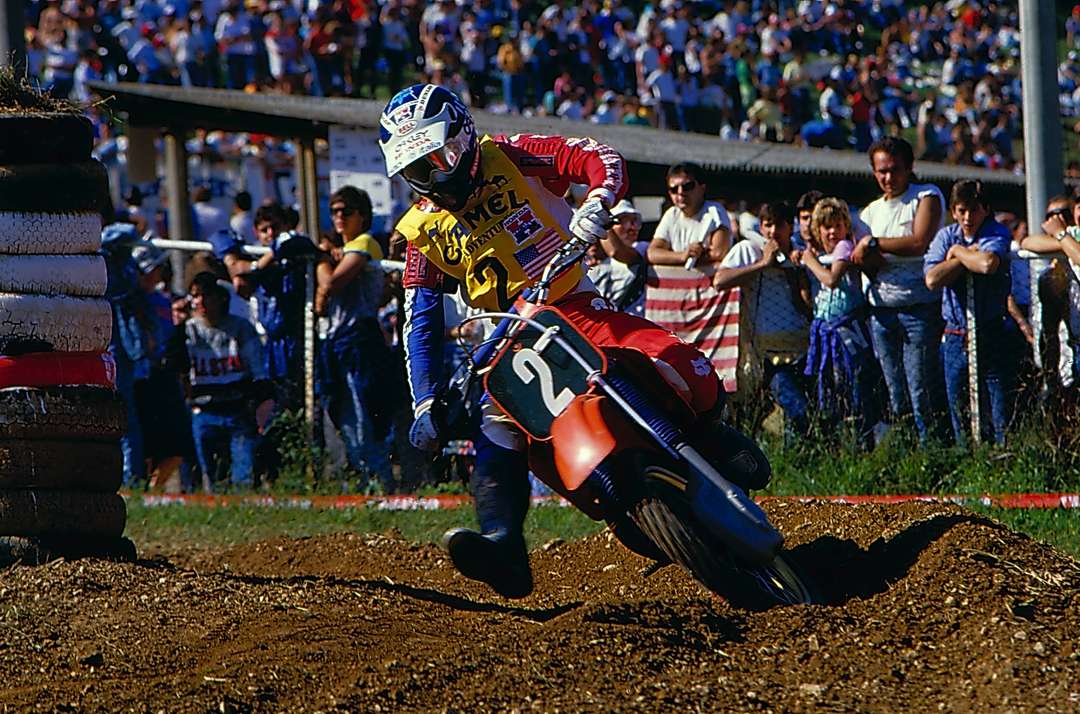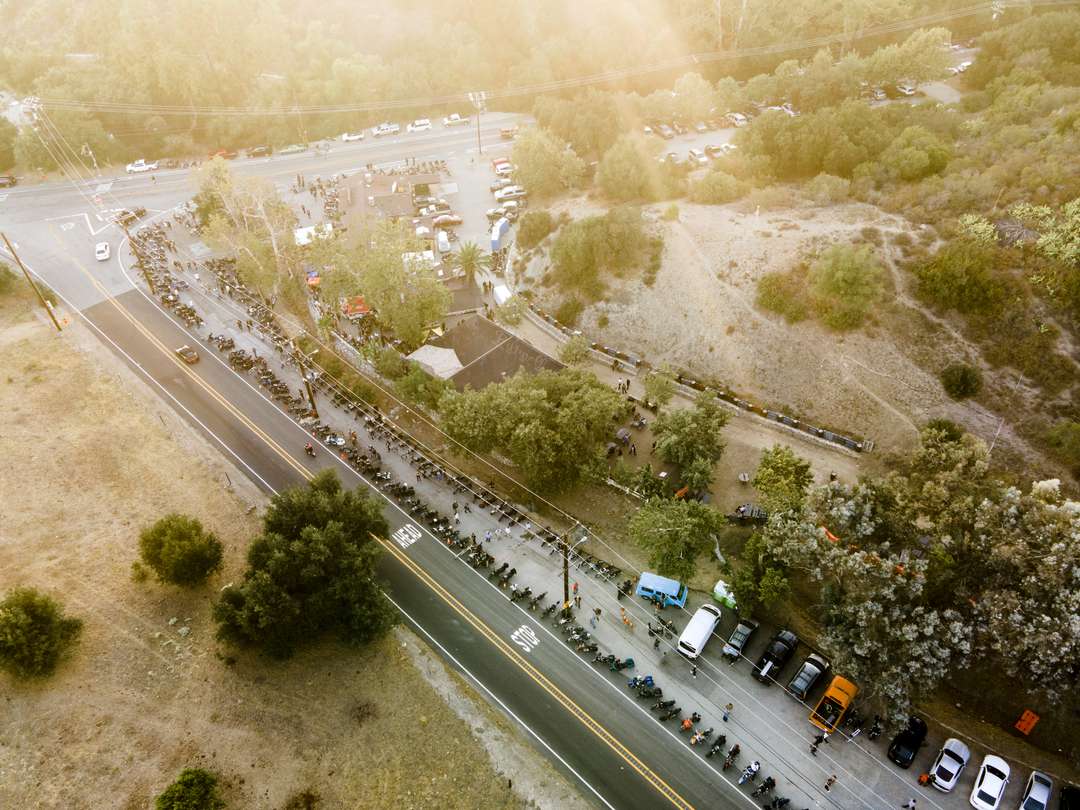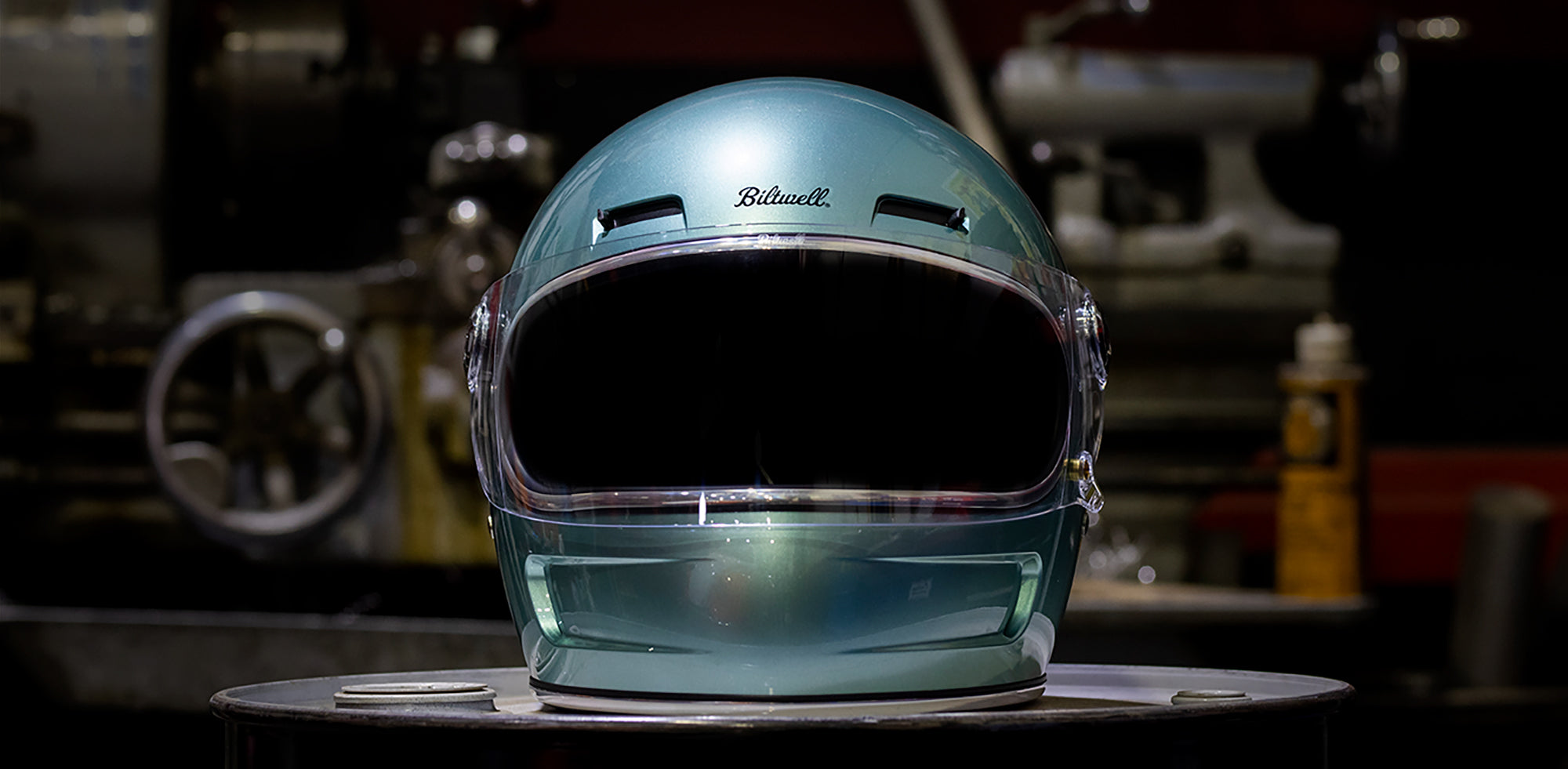Dumb Ideas Require Big Moves. This Is Our Biggest Ever
In 2019 I was making reservations for a ferry trip from Washington to Alaska so the Biltwell gang could ride choppers to the Arctic Circle. Easy enough, right? When the nice lady at the reservation center quoted an enormous per-bike cost for the boat ride, I asked how much we could save if the bikes were in a truck. When she said we’d only be charged for the vehicles whose wheels touched the deck, it clicked. The team rolled their eyes when I told them we were going to build a giant, self-contained chase vehicle, but deep in my evil brain I knew it was the right thing to do.
“It's basically a 20,000lb chopper.”—JOSH
A couple months later, our friends Yeti and Yolo in Montezuma, IA, procured a low-mileage US Army LMTV M1078 troop carrier. This is the rig that replaced the venerable Deuce and a Half that’s ferried troops and supplies all over the world for over half a century. Modernized with a 6.6-liter Cat diesel engine and Allison 7-speed automatic transmission, our LMTV is easier to drive than an old Deuce, and more comfortable too, thanks to its cab-mounted air bags.
YETI BUILT
After handling the first round of major modifications solo, JD Sansaver and I flew to Iowa to lend Yeti a few more helping hands. Tasks that week included situating the truck’s box, rebuilding the air brake system, and sussing dozens of other odds and ends. Anything that wasn’t mission-critical was sold off or tossed. Yeti installed a Tommy Lift and mini roll-up garage door on the box to make loading bikes easier. In down position the lift gate acts like an aluminum deck to hold a couple more bikes in a pinch. We won’t go far in that configuration, but it’ll save us big bucks when it’s sailing to Alaska.
YETI & YOLO
What’s your day job?
Grill jockey and lead fleet service tech at Yeti-Built.What were you responsible for on this project?
Hunting down a good quality candidate for the build, then de-militarizing the truck, coordinating the composite box and roll-up door build and installation, interior refresh and suspension buildout, then some general service and mechanical preparations.Did the thing's size make working on it more difficult?
It’s a huge rig and you’d think that would make things more difficult, but the truth is, it just made things bigger!Which part of the project did you enjoy most?
When I was jammin’ down dirt roads in Baja behind the wheel of this thing a year after the project started, I’m stoked how a silly conversation with the guys at Biltwell went from “What if?” to “Oh shit!” The lesson I learned is even BIG dumb ideas can become a reality with a little hard work.Any regrets?
My biggest regret about this project is that I don’t get to drive this beast every day.After using it on its first big trip, what’s your favorite part of the LMTV?
My favorite aspect of this build after getting a ton of seat time on our last adventure is the overall drivability and capability of this machine.
FMF CERTIFIED
After spending a year at Yeti’s compound, we drove the LMTV back to Flying Monkey Fab in SoCal so JD could work on it. JD cranked out a long list of to-do’s, not least of which included installing a fridge, mounting a welder and generator under the frame rails, adding pop-out windows on the box, and building a massive roof deck. I designed the laser-cut roof rack over the cab and side rails for the box, which we had powder coated for durability. Other tweaks while the truck was at FMF include the front bumper that doubles as a buffet table, and the most magical slide-out staircase anyone will ever see.
JD SANSAVER
What’s your day job?
I’m a custom fabricator.
What were you responsible for on this project?
I modified the LMTV to accommodate all of the needs for a chase vehicle. Those installs and upgrades included storage boxes for tools; a refrigerator; the welder and generator; and building and installing stairs, windows, a roof rack, water storage, shower, and ladders. Also, I helped with the cool checkered paint job!It’s huge. Did that make things more difficult?
Yes! My knees were sore from climbing up and down a ladder!Which part of the project did you enjoy the most? (or are most proud of?
The undercarriage storage boxes and the slide-out ladder are pretty cool.Least favorite?
Having to give it back! I had a lot of fun on this job!After using it on this first big trip, what’s your favorite aspect of the build?
Watching the Circle of Death on the EDR from the deck on the roof was pretty awesome.
ROUSER TIME
When JD was done, the rig came back to the Biltwell tree fort in Temecula just in time for Rouser to show up from Panama. Rob’s hit list included pulling miles of wire for lighting and charging, and finalizing dozens of electromechanical functions and upgrades. I built a little .30-cal ammo can into a locking fuse box/master switch/USB station that’s linked to two 12-volt batteries to run all “house” functions. Those batteries are charged by the dual alternator that also sends juice to the bank of 24-volt batteries that start the diesel engine. On one last slam before this year’s El Diablo Run, the team and I created awning supports, braced the mirrors, and stickered it all up with help from Biltwell ops manager BF Josh. With nothing left to do and everything to prove, we took our LMTV on its second official adventure: a 250-mile drive through the Mojave Desert for the Biltwell 100.
“ROUSER” ROB GALAN
What’s your day job?
That’s a tricky question. To put it simply, I’m a full-time sarfing (Rouserspeak for “surfing”) expat who lives in Panama with a part-time job as the mechanic and video personality at Biltwell. The commute is rough!What were you responsible for on this project?
I was tasked with most of the electrical add-ons as well as a few other things like roof vents, exterior D-track, fire extinguishers, etc.It’s huge. Did that make things more difficult?
Its size didn’t make working on the LMTV more difficult, but it definitely made it more time-consuming. Up and down ladders, in and out of the rear box using the lift gate, crawling around the CAT diesel engine to run wiring. I found myself paying more attention to what tools and equipment I would need before climbing all over the rig to start a new project.Which part of the project did you enjoy the most? (or are most proud of?
I love having a PA system in my personal rig, so when I was tasked to install one in the LMTV I was stoked. It’s the same PA/horn system that emergency vehicles use. The horn is loud and distinct, a real attention-getter. Same with the PA—it’s neat to be able to yell, “Get out of the way!” from inside the cab and being heard over every car and motorcycle in the vicinity.Least favorite?
Oh man, I must have burned over eight hours just drilling holes through 1/4-inch steel all over the rig. Any time I needed to install a rivnut, mount something, or make an access hole I was having to drill for what seemed like hours. I probably resharpened drill bits more than two dozen times in a two-month work session. My wrists hurt just thinking about it!After using it on this first big trip, what’s your favorite aspect of the build
The fact that we completed our first mission with great success. The LMTV did everything we asked from it. It kept our food cold, our gear dry, all tools ready for action, and provided shade in the Baja sun. My most memorable moment was when I pulled out the welder, fired up the generator, and repaired Geoff’s Dyna on the side of a dirt road. We never skipped a beat on Operation Tranquillo, and a major part of that was due to the LMTV.
PRESSURE MAKES DIAMONDS
Ten miles out from Biltwell HQ, the LMTV blew an oil line. Two hours later, we had found and fixed the 20-dollar part and hauled ass—top speed on this beast is a steady 56mph—to Ridgecrest, CA, in the heart of the SoCal desert. The rest of the trip was hassle-free. A slow leak from a cracked timing cover will make sure the LMTV’s undercarriage never rusts, and we’ll just keep checking the oil and topping off as needed. On the EDR shakedown to Baja and back a few weeks later, the LMTV was flawless, and that trip included cooking, camping, and roadside motorcycle repair for a dozen people over ten days.
The mission?
• Have room for a couple bikes without a trailer
• Sleep a few bodies depending on the conditions
• Provide work space for fixing bikes
• Haul food and supplies for a dozen people
• Become a mobile kitchen for small group
• Represent Biltwell at events of all kinds
It was luxurious to be off the grid with ten bikes and have all the food, tools, parts, equipment, and cold beer we needed to sustain everyone. Inside the box, kayaks fit on the modular cot system JD designed perfectly. We used the LMTV’s roll-out shade and on-board air compressor to quickly repair primary belts on two choppers that were eaten by shortcuts across the Mexican desert. The front bumper/buffet station and adjustable Tommy Lift made food prep and serve easy.
“As our dumb ideas go, this is the biggest so far.”—OTTO
Just like the choppers we built this thing to transport, the Biltwell LMTV will always need some work, and the list of upgrades will likely never end. As for our Alaska adventure by ferryboat, COVID killed those plans last year, but we’ll give it another try in 2022… with as many motorcycles as our loveable beast can handle.
Specifications:
Model: M1078
Engine: Caterpillar 3115 turbo diesel, 6-Cylinder, 6.6L
Transmission: Allison 7-Speed MD3070PT
Tire Size: 47”
Suspension: Icon
Sleeps: 6 but depends on configuration
Height: 150”
Width: 96”
Length: 272”
Weight: 16, 499 as bare cab and chassis
Max speed: 60mph
Add-ons: Snomaster fridge, K&N LED lights and pre runner rear light, back up camera, tool boxes, Honda generator, Miller diversion 180 welder, Tommy Lift hydraulic gate, CTIS delete, rally vents on roof, GPS speedometer, loudspeaker/siren, 3 roof racks, cup holders and loads of other stuff from www.eriksmilitarysurplus.com
 The awning is a cheap RV take-off that we modified to make more rugged. The windows on habitat were also inexpensive RV store items and pop open all the way for maximum ventilation when stopped. Just storing ten camp chairs is a chore with any other rig. We just toss them into the huge gyspy rack above and behind the cab.
The awning is a cheap RV take-off that we modified to make more rugged. The windows on habitat were also inexpensive RV store items and pop open all the way for maximum ventilation when stopped. Just storing ten camp chairs is a chore with any other rig. We just toss them into the huge gyspy rack above and behind the cab.
 We normally outrun the Pig on the highway but on a silty baja backroad, this thing is right at home and ready to work.
We normally outrun the Pig on the highway but on a silty baja backroad, this thing is right at home and ready to work.

 The lift gate works as an elevator to get heavy stuff like motorcycles and full beer coolers up to the habitat. It also makes a fantastic buffet table or work bench.
The lift gate works as an elevator to get heavy stuff like motorcycles and full beer coolers up to the habitat. It also makes a fantastic buffet table or work bench.
 One of JD’s masterpieces– the stairs tuck away over and behind the under-frame box that holds the welder and generator. We put that stuff on the passenger side for a little added safety when working on bikes roadside. Aft of the stairs, built between frame rails is a sliding aluminum tray that holds tools, parts and materials.
One of JD’s masterpieces– the stairs tuck away over and behind the under-frame box that holds the welder and generator. We put that stuff on the passenger side for a little added safety when working on bikes roadside. Aft of the stairs, built between frame rails is a sliding aluminum tray that holds tools, parts and materials.
 Inside the camp box is a modular set up based on E-track. With this design, we can install any number of custom made cots to sleep on or stash gear. We slid kayaks over the top beam in this photo for easy transportation of the usually awkward boats. The E-track continues around the perimeter inside, about a foot off the floor, for lashing down motorcycles.
Inside the camp box is a modular set up based on E-track. With this design, we can install any number of custom made cots to sleep on or stash gear. We slid kayaks over the top beam in this photo for easy transportation of the usually awkward boats. The E-track continues around the perimeter inside, about a foot off the floor, for lashing down motorcycles.
 The Snomaster CL80 12v fridge is a total game changer. We kept beer and sodas on ice in another cooler and kept the perishable food in this glorious contraption. It drew a lot less power than expected and worked flawlessly. Above the slide out fridge is a pantry shelf that gobbled up a ton of canned food, tortillas, fruit and veggies.
The Snomaster CL80 12v fridge is a total game changer. We kept beer and sodas on ice in another cooler and kept the perishable food in this glorious contraption. It drew a lot less power than expected and worked flawlessly. Above the slide out fridge is a pantry shelf that gobbled up a ton of canned food, tortillas, fruit and veggies.
 This night I slept up top, a couple more were inside and everyone else took a spot on the ground. On a long trip it’s nice to have a few options, and feels luxuriuous when it’s your turn for a cot.
This night I slept up top, a couple more were inside and everyone else took a spot on the ground. On a long trip it’s nice to have a few options, and feels luxuriuous when it’s your turn for a cot.
 “If 10-year old me designed the ultimate truck, this would be it.”—BILL
“If 10-year old me designed the ultimate truck, this would be it.”—BILL
 Odds & Ends
Odds & Ends Parts & Labor Expo
Parts & Labor Expo Biltwell 100
Biltwell 100 El Diablo Run
El Diablo Run People's Champ
People's Champ Helmet Auction
Helmet Auction Motofest
Motofest Kernville Kampout
Kernville Kampout WTF Blog
WTF Blog P&L Magazine
P&L Magazine P&L Podcast
P&L Podcast




